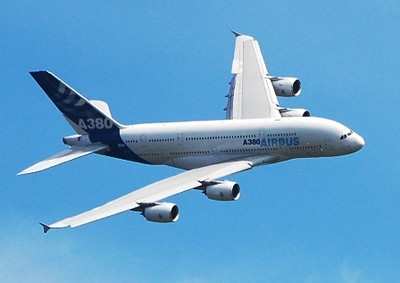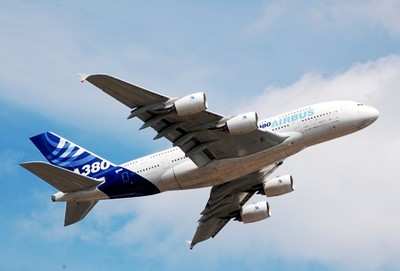Wed, Mar 03, 2010
Expect Fuel Savings, Reduced CO2 Emissions
Heathrow, NATS, Singapore Airlines and Airbus have launched an
improved departure procedure for the Airbus A380, which is
projected to save fuel and reduce CO2 emissions while remaining
within the airport's strict noise procedures. This new procedure is
estimated to save an additional 660 lbs of fuel per flight,
equating to one metric ton of emissions of CO2 on a flight to
Singapore, as well as reducing NOx emissions.

The companies worked together over the last year to develop the
new airline procedure, which has been put into place immediately.
A380s departing Heathrow now use less power when taking off. Once a
height of 1,500 feet has been reached, the aircraft uses flexible
acceleration up to 4,000 feet, before continuing its journey.
"The A380 represents the most significant step forward in
reducing aircraft fuel burn and resultant emissions in four decades
whilst offering greater comfort on board," said Tom Williams,
Executive Vice President Programs, Airbus. "In fact, the A380
consumes less than three liters of fuel per passenger per 100
km."
The A380 is also significantly quieter than other large
aircraft. It produces half the noise energy at takeoff and cuts the
area exposed to equivalent noise levels around the airport runway
by half. At landing the A380 is producing three to four times less
noise energy, contributing significantly to reduce the noise impact
whilst enabling the airline to carry more passengers per
flight.

Jane Dawes, Operational Noise and Air Quality Manager from
Heathrow said, "The Airbus A380 is already the most fuel efficient
aircraft in commercial service, burning 17 per cent less fuel per
passenger than other large aircraft. By 2020 one in ten flights at
Heathrow could use A380s. It is important that we work constantly
with our airlines to improve operating processes, and the
introduction of these new departure procedures demonstrates our
commitment to reducing emissions."
More News
Homing [ICAO] The procedure of using the direction-finding equipment of one radio station with the emission of another radio station, where at least one of the stations is mobile, >[...]
Aero Linx: European Regions Airline Association (ERA) The European Regions Airline Association (ERA) represents a diverse membership of over 50 airlines and more than 150 associate>[...]
A Few Questions AND Answers To Help You Get MORE Out of ANN! 1) I forgot my password. How do I find it? 1) Easy... click here and give us your e-mail address--we'll send it to you >[...]
While On Short Final, About 300 Ft, The Pilot Performed A Forced Landing Near Trees On September 7, 2025, about 0932 eastern daylight time, a CubCrafters Carbon Cub EX airplane, N4>[...]
Severe Icing The rate of ice accumulation is such that ice protection systems fail to remove the accumulation of ice and ice accumulates in locations not normally prone to icing, s>[...]
 ANN's Daily Aero-Term (10.13.25): Homing [ICAO]
ANN's Daily Aero-Term (10.13.25): Homing [ICAO] ANN's Daily Aero-Linx (10.13.25)
ANN's Daily Aero-Linx (10.13.25) ANN FAQ: Q&A 101
ANN FAQ: Q&A 101 NTSB Prelim: CubCrafters Carbon Cub
NTSB Prelim: CubCrafters Carbon Cub ANN's Daily Aero-Term (10.14.25): Severe Icing
ANN's Daily Aero-Term (10.14.25): Severe Icing




